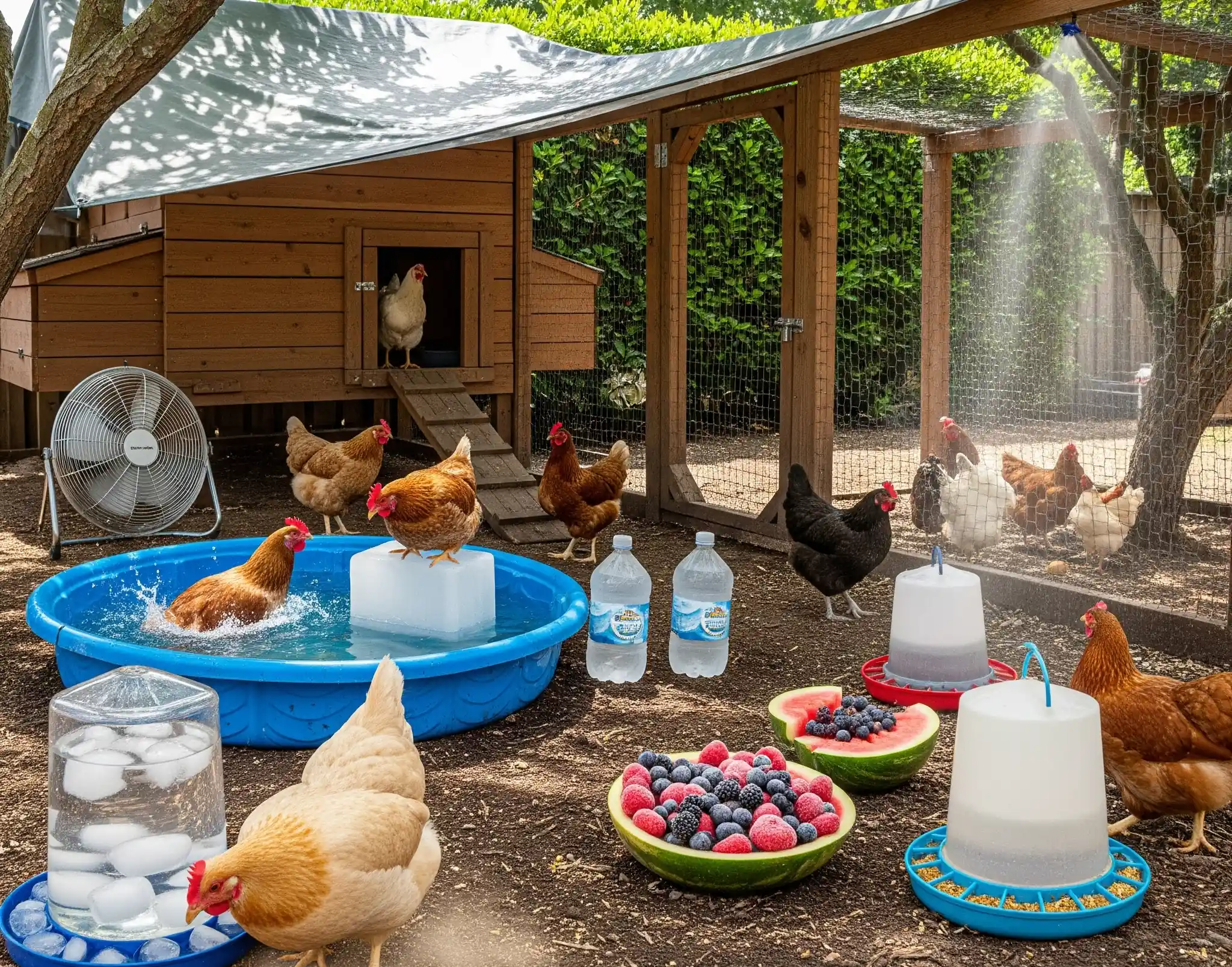Keeping chickens cool during a heatwave is crucial, especially for backyard flocks. Chickens cannot sweat like humans do, so they rely on panting and seeking shade, making them vulnerable to heat stress.
This guide will share simple, actionable ways to help your chickens, including my experiences with my chickens, stay comfortable in hot weather.
How to Recognize Heat Stress in Chickens?
Identifying heat stress early is vital. Acting early can prevent serious health issues, so check your chickens regularly during periods of high heat.
- Panting: Rapid breathing with an open beak is a common cooling mechanism.
- Holding wings away from the body: Increases air circulation around the body.
- Lethargy: Chickens may appear sluggish, moving less than usual.
- Reduced appetite: Heat can suppress their desire to eat, leading to energy loss.
- Pale combs and wattles: Indicates diminished blood flow, a sign of overheating.
- Some other signs include diarrhea, Seizures and convulsions, a decrease in egg production, Thin shells on eggs, and staggering or limping.
For my flock, I observed these symptoms during peak heat, which guided my interventions. Monitoring is crucial, especially for heavier breeds like Orpingtons, which are more susceptible to heat stress due to their larger size.
Why is Cooling Chickens Important?
Heatwaves pose significant risks to chickens, particularly in hot climates like Australia, where temperatures can soar above 40°C (104°F) during summer months.
Research shows that chickens, unable to sweat, rely on panting and spreading wings to cool down, which can lead to dehydration and reduced egg production if not appropriately managed.
This is especially critical for breeds with dense feathering, such as Silkies, which may struggle more due to their unique plumage.
My own experience last summer, during a heatwave with temperatures exceeding 100°F, underscored the importance of proactive care. I noticed my chickens panting and holding their wings away, prompting immediate action to ensure their comfort.
Certain breeds, such as Silkies, Satins, and Brahma, require extra care due to their fluffy feathers, which can trap heat. Silkies tolerate moderate heat (up to 75°F) but struggle in temperatures above 85°F, requiring insulated coops, fans, or cooler environments.
Research also suggests breeds with large combs, like Leghorns, are more heat-tolerant, while heavier breeds like Orpingtons need more attention.
Recent studies show that temperatures above 90°F can reduce egg production by up to 20%, with humidity exacerbating the issue. In the United States, where heatwaves can reach 40°C, increased mortality rates occur without proper care, emphasizing the need for these strategies.
My Personal Experience and Practical Insights
(add own images)
Last summer’s heatwave, with temperatures above 100°F, was a test for my flock. I implemented all these strategies: multiple iced water sources, shaded runs with tarps, ventilated coops with fans, frozen treats, and a moist dust bath area.
Creating a cool, damp spot for dust bathing was particularly effective, as chickens would lie in the soil to lower their body temperature.
The kiddie pool, initially ignored, became a favorite after a few days, with chickens wading to cool their feet. These actions kept my chickens healthy, reinforcing the importance of proactive care.
10 Best Ways to Keep Chickens Cool in Summer/Heatwave
Here’s a breakdown of each method/strategy, with personal tips and scientific backing:
1: Provide Ample Shade
Shade is vital to protect chickens from direct sunlight, which can make areas 40°F hotter. I use shade cloths, old doona covers, and thick tree branches over the coop and run. In Australia, where summers are extreme, this is a must. Image Pam’s beautiful run with fruit umbrellas as inspiration for creative shading.
2: Ensure Proper Ventilation in the Coop
Good airflow prevents heat buildup, manages ammonia, and supports respiratory health. Check the coop airflow by ensuring windows and vents are open, replacing perspex with wire mesh if unsure.
I avoid box-style coops covered on three sides without a gap at the top, as they can be death traps. Warm nights are important, so ensure roosting space isn’t squished, with at least 4 square feet indoors and 5-10 outdoors per bird to prevent overcrowding.
3: Offer Cool, Clean Water
Hydration is key, with chickens needing cool, clean water to drink, especially in heat. I’m not a fan of nipple drinkers or tiny-cup styles during extreme times; they’re too challenging. Instead, I use 9-litre buckets situated in the garden’s coolest spot, replacing daily or every second day, reusing veggie containers if needed.
Place drinkers under shade trees, with multiple spots ideal in case one tips over. Freeze ice cream tubs if struggling, but after asking fellow chook people, the consensus was iced water is better than warm.
For bantams like Belgian Bantams or Sebrights, use appropriately sized massive ceramic dog bowls on pavers or add a brick to buckets to prevent drowning; big buckets won’t tip. Check automated systems, as connecting pipes and hoses can get scalding in the hottest part of the day.
4: Use Frozen Treats and Hydrating Foods
Frozen fruits like watermelon, berries, or frozen corn are cooling snacks. I also offer chilled cucumber, iceberg lettuce, and melons with high water content to increase nutrient intake.
Studies show hydrating treats help, but limit to 90/10 healthy treats to Farm Protein Blend Hens, keeping dietary priority first. Discard wet dishes after an hour to avoid illness-causing bacteria, and avoid carbohydrate-heavy treats like cracked corn or bread during heat.
5: Create Dust Baths in Cool Areas
Dust bathing helps chickens cool down and manage mites. Set up in shaded, moist spots with soil, mulch, or leaf litter. I hose down the area to keep it damp, and my chickens can’t resist digging into the cool dirt, splashing their wattles for comfort.
For younger chicks under 16 weeks, be cautious as wetting can lead to Coccidiosis issues. A kiddie pool with wet sand or a shallow container works for them to lie near, continuing to be moist naturally.
6: Adjust Feeding Times
Feed during cooler morning or evening hours to reduce metabolic heat. Provide unlimited access to long, dry pellets, mash, or complete whole grains via a Feeder, but limit scratch mix treats during heat to rehydrate.
Normal feeding practice includes fresh-from-the-garden fruits and vegetables as summertime snacks for potluck picnics, but ensure a complete, balanced diet to stay productive.
7: Use Misters or Sprinklers
Evaporative cooling moistens the air, especially with a fan breeze. I add misters outside, spraying onto the roof cover for air flow, or use a greenhouse misting system with an irrigation timer for automation.
Wetting down the dust bathing area helps, but you’re trying to cool the surrounding air, not soak the chickens. Never fully immerse them, as it can interfere with natural processes, lifting feathers to allow airflow to the skin.
8: Provide Electrolytes and Supplements
In a heat wave, chickens need to replenish vitamins and electrolytes to make them thirsty, which is what you want. I have a sachet of 35°C Heat+Stress on hand for unpredictably hot stretches, a veterinarian-formulated, great-tasting formula packed with natural minerals.
Probiotic supplements like 2Pak improve health, with studies linked to range resistance, particularly Zinc, A, and E, and ascorbic acid for a bang for your buck.
Mega Mineral covers yeast, protein concentrate found in baker’s or brewer’s, easier on a home scale. Watch a video for the best temperature check on recently incorporated practices.
9: Monitor and Manage Coop Temperature
Use thermometers to track temps, aiming for below 90 degrees, as above can be the danger zone, especially at 120F in deserts like May Arizona. Insulate by stacking straw bales against the west side, dramatically breaking heat, or secure hay-band rope with seen refrigeration panels and other recycled materials for great success.
White-washing painting surfaces white reflects the sun, a new concept to lower core temperature, and swap solid doors for a screen to keep lights off, reducing bedding to two inches to avoid trapped heat with peat moss.
10: Bring Chickens Indoors in Extreme Cases
If temps spike, bring the chickens inside to the air conditioning. The easiest way to manage is to keep your pet in a pet carrier until the heat passes. I experienced this during May and June, when temperatures reached 50°C.
Monitor closely, offering affected areas along the keel and chest, and note the duration. Additionally, purchase a dispenser of mineral supplements for the remainder.
12 Heat-Hardy Chicken Breeds
Here are some breeds for you if you are living in the hot areas:
1: Orpington
2. Easter Egger
3. Barred Plymouth Rock
4. Rhode Island Red
5. Welsummer
6. White Leghorn
7. Brahmas
8. Andalusians
9. Fayoumi
10. New Hampshire Red
11. Sumatra
12. Minorca
Conclusion and Recommendations
Keeping chickens cool during heatwaves requires hydration, shade, ventilation, cooling treats, and additional methods, with special consideration for heat-sensitive breeds.
My experience validates these approaches, ensuring a healthy flock even in extreme heat. For readers, I recommend regular monitoring, implementing these tips, and consulting a veterinarian for supplements such as electrolytes during severe heat waves.
Answers to Some Questions
How to Keep Chickens Cool in Hot Weather?
Chickens can struggle in high temperatures, so it’s vital to help them stay cool, especially in 100-degree weather or places like Arizona. Here are some simple ways to do this:
- Shade and Shelter: Ensure they have ample shade by utilising trees, tarps, or shade cloths to protect them from direct sunlight.
- Cool Water: Always provide fresh, cool water. Add ice or frozen bottles to keep the water cold, and place it in a shady area.
- Ventilation: Keep the coop airy with good airflow. Use fans if possible to help circulate the air.
- Misters: In dry climates, use misters to cool the air around the coop, which can significantly lower temperatures.
- Water Pools: Let chickens stand in shallow water pools to cool their feet, as this helps them regulate body temperature.
- Frozen Treats: Offer frozen fruits or veggies as a cool snack to help them beat the heat.
- Feeding Times: Feed them during cooler times, such as early morning or late evening, to minimise heat stress.
Are Chickens Okay in 90-Degree Weather?
At 90°F, chickens can survive, but they might feel stressed. It’s best to provide shade, cool water, and other cooling methods to keep them comfortable and healthy.
How Hot is Too Hot for Chickens in Summer?
Research suggests that temperatures above 85-90°f can cause heat stress, and those above 100°f can be dangerous if not properly managed. Always watch for signs like panting or lethargy and help them cool down.
Can You Spray Water on Chickens to Cool Them Down?
It is generally not recommended to spray water directly on chickens, as they tend to dislike it and it may cause them stress. However, in extreme heat, a light misting might be okay, but it’s better to use misters for the air or let them stand in shallow water.
How to Keep Chickens Cool in Arizona?
In hot, dry Arizona, extra steps can help:
- Use misters for evaporative cooling, which works well in dry climates.
- Choose heat-tolerant breeds, such as Orpington or Barred Plymouth Rock.
- Ensure the coop has shade and good ventilation.
- Provide multiple cool water sources to keep them hydrated.

Hello! I’m Ibrahim, the owner and writer of this blog. I run a chicken farm with 160 chickens, and I’ve gained a lot of knowledge about raising and caring for them. Now, I want to share my insights and experiences with you to help you in chicken keeping.

